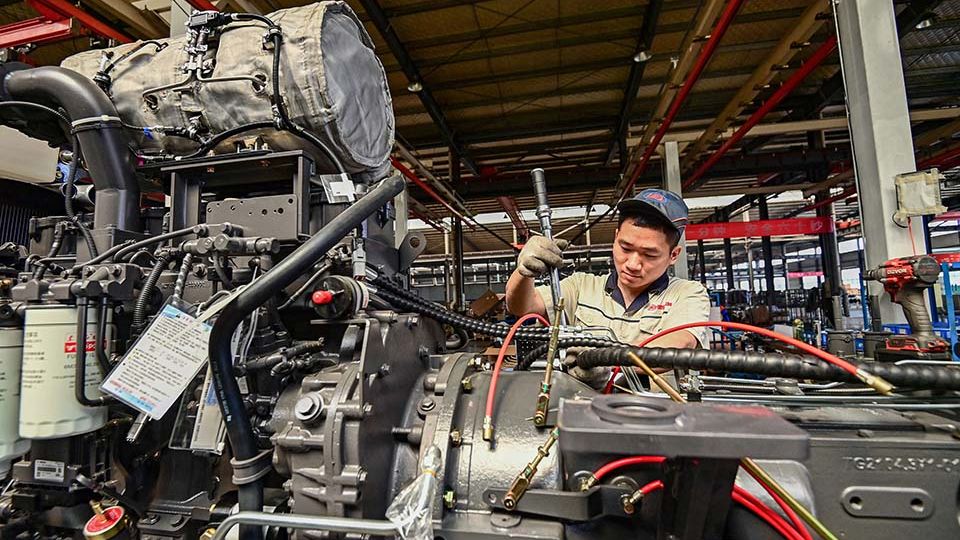May 28, 2025
BEIJING – China’s economy is maintaining strong momentum as major industrial enterprises posted accelerating growth in April, official data showed on Tuesday, suggesting robust economic resilience despite trade concerns.
Officials and economists said the positive trends underscore the effectiveness of stimulus policy measures in cushioning the impact of the United States’ tariff hikes and stabilizing market expectations.
Their comments came after Moody’s Ratings affirmed on Monday China’s long-term credit rating of A1, both in domestic and foreign currencies, while maintaining a negative outlook. The A1 rating, four notches below the top of Moody’s 21-notch rating scale, indicates a low credit risk.
Although the outlook remained negative, the unchanged rating reflects confidence in China’s medium- and long-term economic fundamentals. Moody’s Ratings said the affirmation of the A1 rating takes into account China’s large, dynamic economy and capacity for innovation.
Looking ahead, economists believe that China’s economy will maintain stability in the third and fourth quarters, given ample policy space and tools to withstand mounting external uncertainties. Meanwhile, strong fiscal stimulus measures are needed to boost domestic demand and shore up confidence among businesses, such as an additional fiscal package to support infrastructure and consumption.
Data from the National Bureau of Statistics showed on Tuesday that China’s industrial enterprises above designated size — enterprises with annual revenue of at least 20 million yuan ($2.78 million) — saw their total profits jump 3 percent year-on-year in April, up from 2.6 percent growth in March.
In the first four months of the year, industrial profits rose 1.4 percent year-on-year, compared with a 0.8 percent rise in the first quarter.
Yu Weining, a statistician at the NBS, said the rebound is mainly driven by robust earnings of the equipment manufacturing and high-tech manufacturing sectors, aided by the implementation of proactive macro policies.
“Recent trends indicate an improving quality of growth, bolstering economic resilience,” Moody’s Ratings said in a release on the affirmation of China’s A1 rating on Monday. “Improvements in a range of innovation indicators and the large-scale deployment of artificial intelligence suggest that innovation may drive higher productivity growth more effectively.”
Earlier this month, Moody’s downgraded the US’ sovereign credit rating from Aaa to Aa1, pointing to the sustained increase in government debt and interest payments.
In response to Moody’s decision to affirm China’s A1 rating, the Ministry of Finance said that it reflects a positive assessment of the country’s economic outlook.
The ministry said in a statement on Monday that China’s economy has made a strong start this year despite a sluggish global economy, mounting geopolitical tensions and a volatile international trade and economic order, demonstrating strong resilience and vitality.
“Going forward, a combination of incremental and existing policy measures will continue to take effect in a coordinated manner, providing solid support for high-quality development,” the ministry said.
Zhu Haibin, chief China economist at J.P. Morgan, said the global financial services company has raised its full-year GDP growth forecast for China to 4.8 percent from 4.1 percent, assuming that current tariff levels between China and the US remain unchanged through the end of the year.
This upward revision is underpinned by supportive domestic policy adjustments, Zhu said, adding that the current policy easing cycle, which began in late 2024, may continue to focus on fiscal easing led by the central government, further monetary policy support and a rebalancing of economic structure that prioritizes boosting domestic demand and consumption.
Zhu also pointed to structural growth drivers in the Chinese economy, including strengthened market confidence in China’s innovation capacity following the rise of artificial intelligence company DeepSeek, with the strong performance in April of innovation in sectors such as information technology and AI.
However, the imbalance between domestic supply and demand still requires more policy efforts and more time to fully address, Zhu said, as overly low inflation in particular points to the need for further interest rate cuts as well as reductions in the reserve requirement ratio, the proportion of deposits that banks must keep as reserves.
“Retail sales significantly lagged behind market expectations in April, indicating that boosting people’s incomes and employment confidence should be the focus of policy going forward,” Zhu added.
Morgan Stanley also revised its 2025 China GDP growth forecast upward by 30 basis points to 4.5 percent due to reduced tariff headwinds.
Robin Xing, chief China economist at Morgan Stanley, said his team expects Chinese policymakers to leverage the existing policy space and quasi-fiscal tools to support growth up to the third quarter of this year.
“We expect Beijing will introduce a 0.5 trillion yuan to 1 trillion yuan fiscal package to support infrastructure, specifically urban renewal,” he added.


